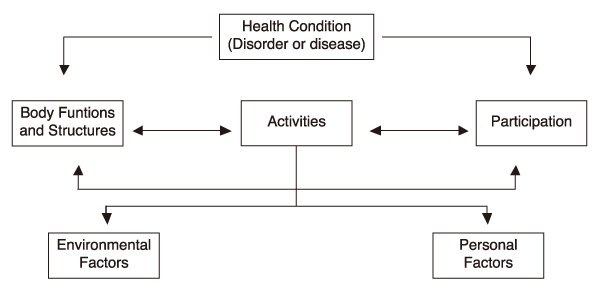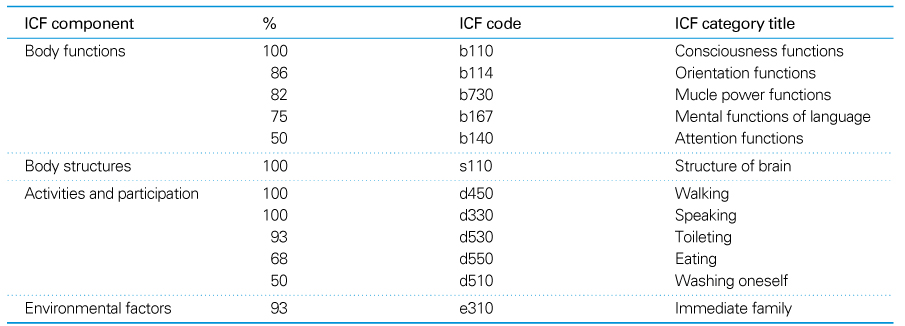 |
 |
- Search
| J Korean Med Assoc > Volume 52(6); 2009 > Article |
Abstract
In spite of a refined classification on the functioning or disability accredited by World Health Organization (WHO, 2001), explicit concepts or definitions of health, disablement and its related terminologies of impairment, disability, handicap, activity limitation and participation restriction are generating considerable confusion in Korea. It is very important to understand the new concepts of these different changing terms in all health related fields. International Statistical Classification of Diseases and Related Health Problems (ICD-10) has reported diagnosis or mortality statistics, but the report did not cover the health status of living populations or information about non-fatal health outcomes. In order to rectify this situation, WHO developed a new tool for the classification of the consequences of disease, namely the International Classification of Impairments, Disabilities and Handicaps (ICIDH) in 1980. Following several revisions, WHO announced the International Classification of Functioning, Disability and Health (ICF) in 2001, which was not based on a medical or a social model, rather on bio-psycho-social and interactive model. WHO recommend the use of the two different classifications to provide relevant and updated information on diagnosis of disease (s) with ICD-10 and also on assessment of functioning or disability with ICF.
References
1. In: Lee KS, editor. Disability evaluation and independent medical examination 2002;Seoul: Jungang Moonwha Co. 15-21.
2. Suh TW. Current status and direction of the expansion of statuatory disabilities in the disability act. Independent Med Exam 2005;2:12-16.
3. Masala C, Petretto DR. From disablement to enablement: conceptual models of disability in the 20th century. Disabil Rehabil 2008;30:1233-1244.
4. World Health Organization: International classification of imapirments, disabilities and handicaps: A manual of classification relating to the consequences of disease. WHO 1980;Geneva.
5. World Health Organization. International classification of functioning, disabilities and health. WHO 2001;Geneva.
6. Jung HY. Impact and application of the international classification of functioning, disability and health in the medical rehabilitation. J Korean Acad Rehab Med 2004;28:401-411.
7. Allan CM, Campbell WN, Guptill CA, Stephenson FF, Campbell KE. A conceptual model for interprofessional education: the international classification of functioning, disability and health (ICF). J Interprof Care 2006;20:235-245.
8. Ustün TB, Chatterji S, Bickenbach J, Kostanjsek N, Schneider M. The international classification of functioning, disability and health: a new tool for understanding disability and health. Disabil Rehabil 2003;25:565-571.
9. Stucki G, Grimby G. Applying the ICF in medicine. J Rehabil Med 2004;44:5-6.
10. de Kleijn-de Vrankrijker MW. The long way from the international classification of impairments, disabilities and handicaps (ICIDH) to the international classification of functioning, disability and health (ICF). Disabil Rehabil 2003;25:561-564.
11. Walsh NE. Global initiatives in Rehabilitation Medicine. Arch Phys Med Rehabil 2004;85:1395-1402.
12. Geyh S, Cieza A, Schouten J, Dickson H, Frommelt P, Omar Z, Kostanjsek N, Ring H, Stucki G. ICF core sets for stroke. J Rehabil Med 2004;44:135-141.
Table 1
Changes of terms for each level in different organizations.

*IOM: U.S. Institue of Medicine; + NCMRR: U.S. National Center for Medical Rehabilitation Research; Adapted from Jung (6) with permission from the Korean Academy of Rehabilitation Medicine.
- TOOLS
-
METRICS

-
Related articles in
J Korean Med Assoc -
Case analysis and justification of physicians, collective actions2021 February;64(2)
New Classification of Cervical Cytology1998 November;41(11)
Basic Principles and Clinical Application of Functional MRI2001 April;44(4)
Current Concepts and Therapeutic Management of Dry Eye2007 September;50(9)
Pancreas and Islet Transplantation in Diabetes2008 August;51(8)








